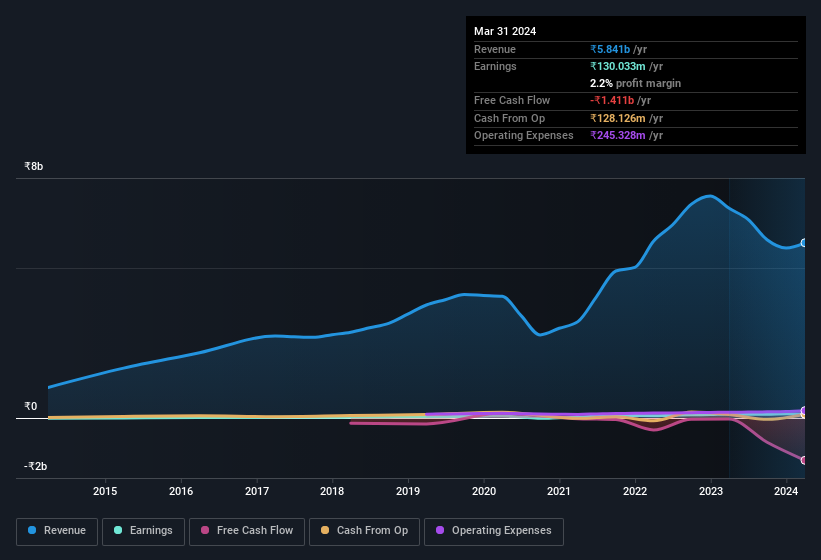Manomay Tex India's (NSE:MANOMAY) Profits May Not Reveal Underlying Issues
The recent earnings posted by Manomay Tex India Limited (NSE:MANOMAY) were solid, but the stock didn't move as much as we expected. We think this is due to investors looking beyond the statutory profits and being concerned with what they see.
Check out our latest analysis for Manomay Tex India

Examining Cashflow Against Manomay Tex India's Earnings
As finance nerds would already know, the accrual ratio from cashflow is a key measure for assessing how well a company's free cash flow (FCF) matches its profit. To get the accrual ratio we first subtract FCF from profit for a period, and then divide that number by the average operating assets for the period. You could think of the accrual ratio from cashflow as the 'non-FCF profit ratio'.
As a result, a negative accrual ratio is a positive for the company, and a positive accrual ratio is a negative. While it's not a problem to have a positive accrual ratio, indicating a certain level of non-cash profits, a high accrual ratio is arguably a bad thing, because it indicates paper profits are not matched by cash flow. To quote a 2014 paper by Lewellen and Resutek, "firms with higher accruals tend to be less profitable in the future".
For the year to March 2024, Manomay Tex India had an accrual ratio of 0.48. As a general rule, that bodes poorly for future profitability. And indeed, during the period the company didn't produce any free cash flow whatsoever. Even though it reported a profit of ₹130.0m, a look at free cash flow indicates it actually burnt through ₹1.4b in the last year. We also note that Manomay Tex India's free cash flow was actually negative last year as well, so we could understand if shareholders were bothered by its outflow of ₹1.4b.
Note: we always recommend investors check balance sheet strength. Click here to be taken to our balance sheet analysis of Manomay Tex India.
Our Take On Manomay Tex India's Profit Performance
As we have made quite clear, we're a bit worried that Manomay Tex India didn't back up the last year's profit with free cashflow. For this reason, we think that Manomay Tex India's statutory profits may be a bad guide to its underlying earnings power, and might give investors an overly positive impression of the company. But the good news is that its EPS growth over the last three years has been very impressive. Of course, we've only just scratched the surface when it comes to analysing its earnings; one could also consider margins, forecast growth, and return on investment, among other factors. If you'd like to know more about Manomay Tex India as a business, it's important to be aware of any risks it's facing. For instance, we've identified 3 warning signs for Manomay Tex India (2 are significant) you should be familiar with.
Today we've zoomed in on a single data point to better understand the nature of Manomay Tex India's profit. But there is always more to discover if you are capable of focussing your mind on minutiae. Some people consider a high return on equity to be a good sign of a quality business. So you may wish to see this free collection of companies boasting high return on equity, or this list of stocks with high insider ownership.
New: Manage All Your Stock Portfolios in One Place
We've created the ultimate portfolio companion for stock investors, and it's free.
• Connect an unlimited number of Portfolios and see your total in one currency
• Be alerted to new Warning Signs or Risks via email or mobile
• Track the Fair Value of your stocks
Have feedback on this article? Concerned about the content? Get in touch with us directly. Alternatively, email editorial-team (at) simplywallst.com.
This article by Simply Wall St is general in nature. We provide commentary based on historical data and analyst forecasts only using an unbiased methodology and our articles are not intended to be financial advice. It does not constitute a recommendation to buy or sell any stock, and does not take account of your objectives, or your financial situation. We aim to bring you long-term focused analysis driven by fundamental data. Note that our analysis may not factor in the latest price-sensitive company announcements or qualitative material. Simply Wall St has no position in any stocks mentioned.
About NSEI:MANOMAY
Manomay Tex India
Manufactures and sells denims and denim fabrics in India and internationally.
Proven track record with imperfect balance sheet.
Similar Companies
Market Insights
Community Narratives



